|
|
Around Pasumalai Thangal Village
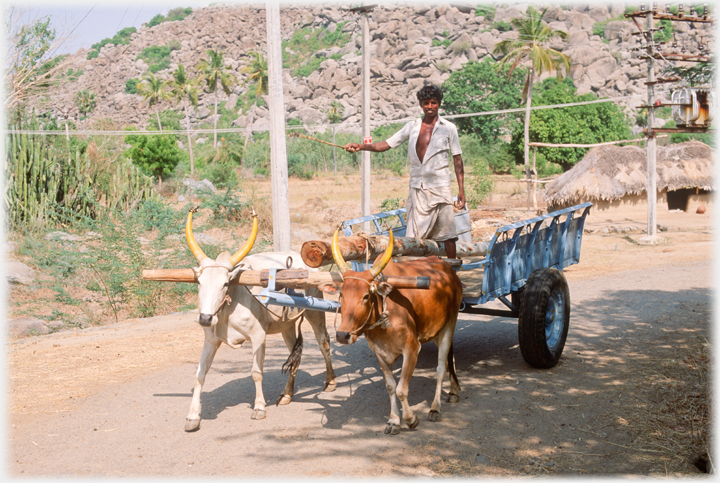 An ox cart
An ox cart
 at the edge of Pasumalai Thangal Village in the state of Tamil Nadu, (another form of this basic vehicle can be seen at the bottom of the page for
Thành Công Village.
at the edge of Pasumalai Thangal Village in the state of Tamil Nadu, (another form of this basic vehicle can be seen at the bottom of the page for
Thành Công Village.
 )
The horns are decorated for the Pongal Festival - see below )
The horns are decorated for the Pongal Festival - see below
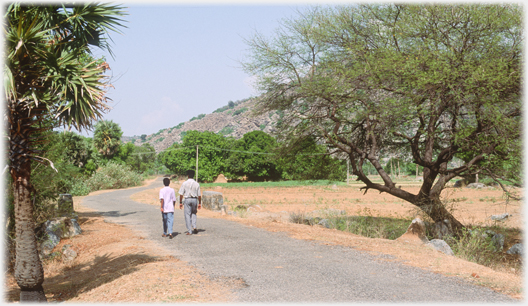 Pasumalai Thangal lies a kilometre or so from the main road where the bus passes. My friend and his nephew lead the way towards the village
This page has pictures of the area around the village of Pasumalai Thangal which is some 150 kilometres south-west of Chennai in Tamil Nadu. It is not isolated as Indian villages go, being a few hours bus ride from the state capital, it has mains electricity, and there is some water 30 metres down, but that level is dropping, so a well 600 metres deep is being planned. But apart from those two services life is as far removed as possible from that seen on the
last pages about Singapore.
Pasumalai Thangal lies a kilometre or so from the main road where the bus passes. My friend and his nephew lead the way towards the village
This page has pictures of the area around the village of Pasumalai Thangal which is some 150 kilometres south-west of Chennai in Tamil Nadu. It is not isolated as Indian villages go, being a few hours bus ride from the state capital, it has mains electricity, and there is some water 30 metres down, but that level is dropping, so a well 600 metres deep is being planned. But apart from those two services life is as far removed as possible from that seen on the
last pages about Singapore.
 The page after this one shows more of the village itself.
The page after this one shows more of the village itself.
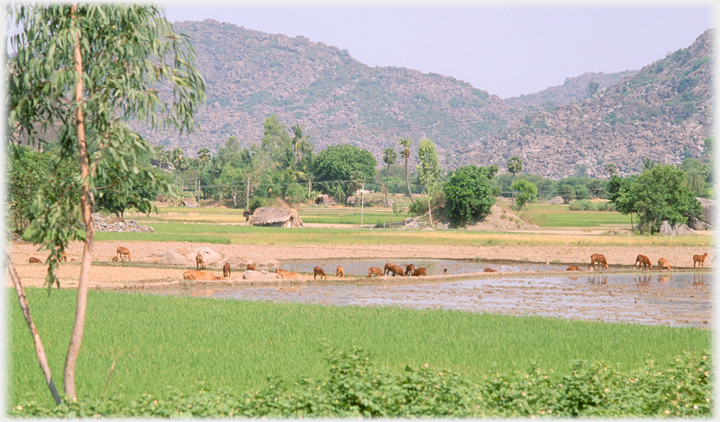 Goats grazing in the fields near the village
Goats grazing in the fields near the village
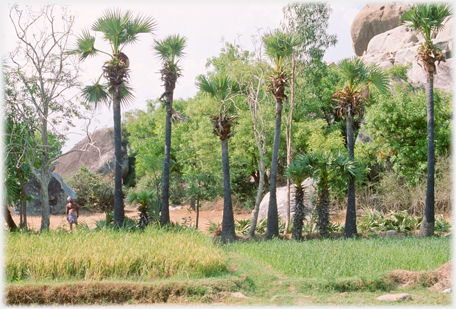 A man, at the left under the trees, watches as palmyra fruit are collected above him. The curved figure can just be seen, but the gathering technique is better illustrated in the pictures below
A man, at the left under the trees, watches as palmyra fruit are collected above him. The curved figure can just be seen, but the gathering technique is better illustrated in the pictures below
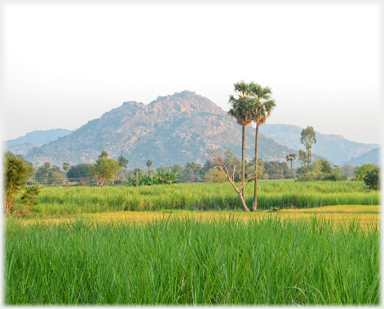 This area of Tamil Nadu is populated by these stony hills standing up in dry contrast to the green of surrounding paddy fields and trees
This area of Tamil Nadu is populated by these stony hills standing up in dry contrast to the green of surrounding paddy fields and trees
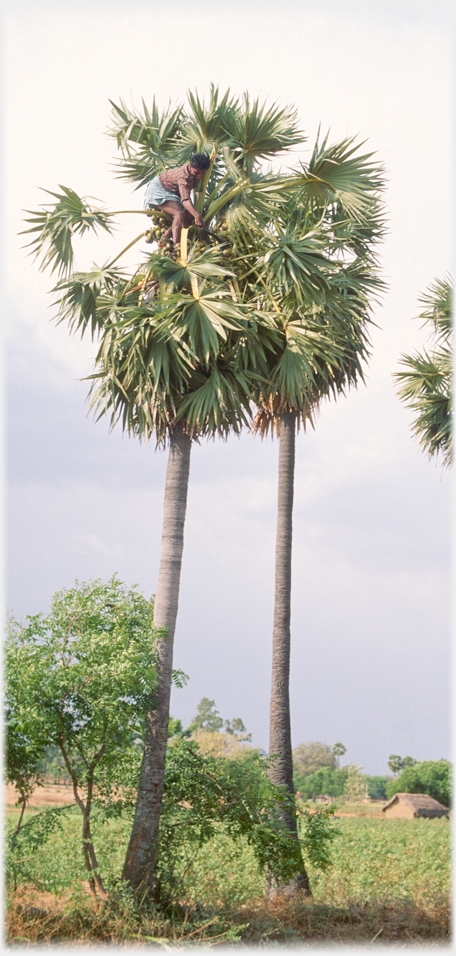
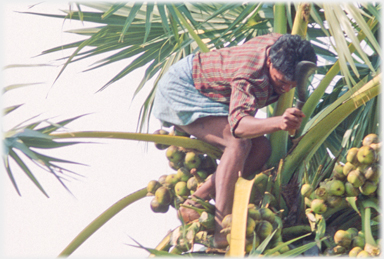 A billhook is being used to cut off the fruit
A billhook is being used to cut off the fruit
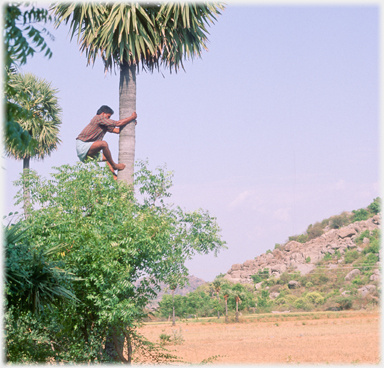 The tree is ascended and descended without aids
The tree is ascended and descended without aids
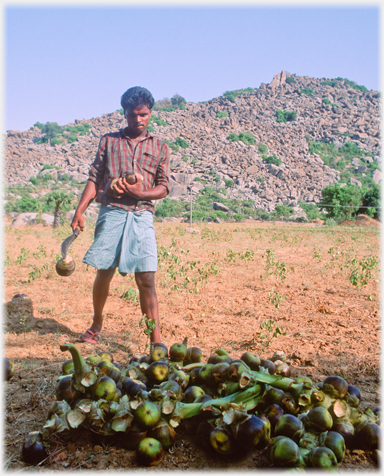 The catch - cut fruits
These trees are Borassus flabellifer, the
palmyra palm,
The catch - cut fruits
These trees are Borassus flabellifer, the
palmyra palm,
 which grows everywhere in, and is the official tree of, Tamil Nadu. It reaches some 30 metres (100 feet) in height, and has many uses including: drinking its sap, eating its sprouts, writing on its leaves, making poles from its trunk, covering roofs with its leaves, and making rope from the fibre of its bark and the stems of its leaves. In these pictures it is of interest for the fruit which we are about to eat. Ayanar, my friend's nephew, is climbing the tree and cutting the fruit from the crown area. Once down he uses the same billhook to open the fruit as he used to dislodge them. It is striking how similar the use of these billhooks is, both here and
in northern Vietnam
which grows everywhere in, and is the official tree of, Tamil Nadu. It reaches some 30 metres (100 feet) in height, and has many uses including: drinking its sap, eating its sprouts, writing on its leaves, making poles from its trunk, covering roofs with its leaves, and making rope from the fibre of its bark and the stems of its leaves. In these pictures it is of interest for the fruit which we are about to eat. Ayanar, my friend's nephew, is climbing the tree and cutting the fruit from the crown area. Once down he uses the same billhook to open the fruit as he used to dislodge them. It is striking how similar the use of these billhooks is, both here and
in northern Vietnam
 3,000 kilometres away.
3,000 kilometres away.
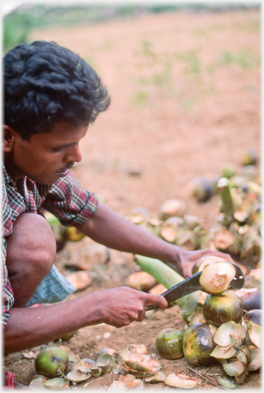 The end of the nut is sliced off...
The end of the nut is sliced off...
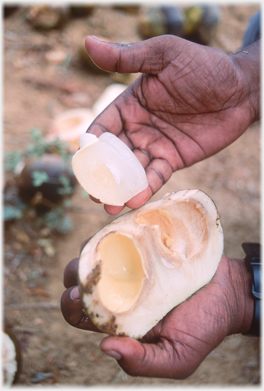 ...revealing the soft fruit...
...revealing the soft fruit...
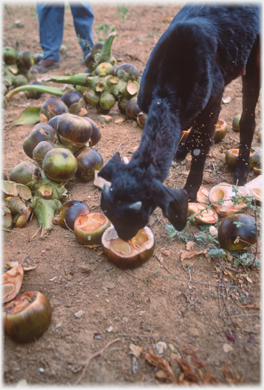 ...a delight for the ever-waiting goats
...a delight for the ever-waiting goats
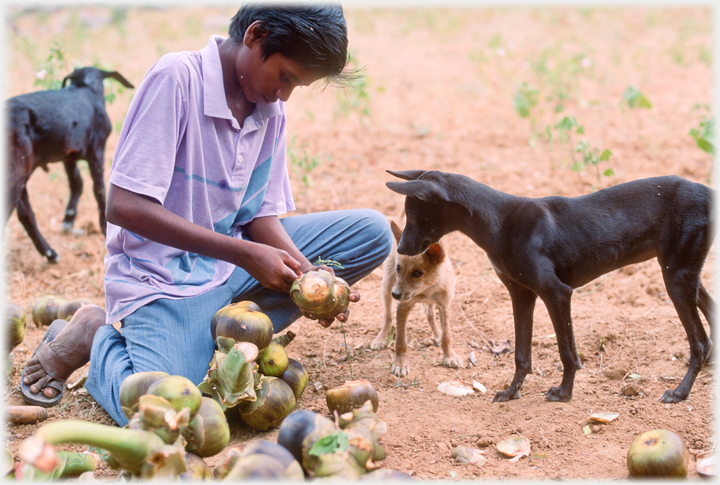 Kumaran opens a fruit, while the dogs salivate in anticipation
Kumaran opens a fruit, while the dogs salivate in anticipation
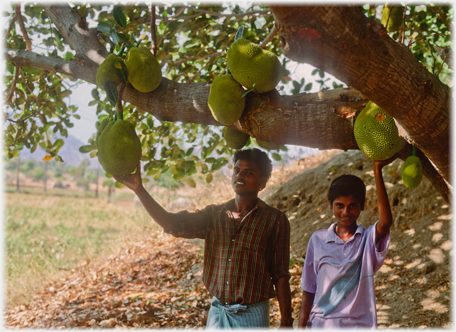 Jackfruit trees
Jackfruit trees
 are related to figs and mulberries and are native to southern India. One tree has some 100-200 of these 'multiple' fruits, each with 100 to 500 seeds. The seeds are eaten raw or used in cooking, they have a flavour reminiscent of banana
are related to figs and mulberries and are native to southern India. One tree has some 100-200 of these 'multiple' fruits, each with 100 to 500 seeds. The seeds are eaten raw or used in cooking, they have a flavour reminiscent of banana
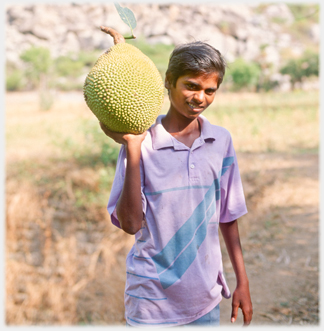 Jackfruits (Artocarpus heterophyllus) are Tamil Nadu's official state fruit. The specimens seen here are mere babies for they can grow to weigh up to 55 kilos each
Jackfruits (Artocarpus heterophyllus) are Tamil Nadu's official state fruit. The specimens seen here are mere babies for they can grow to weigh up to 55 kilos each
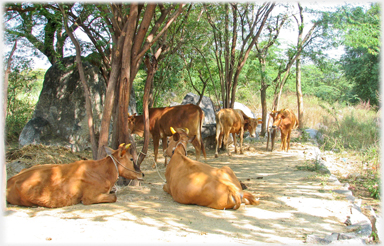 Following the State's official tree and its official fruit, these are its unofficial cattle.
Nattu Madu Cattle
Following the State's official tree and its official fruit, these are its unofficial cattle.
Nattu Madu Cattle
 (literally country cattle) are indigenous to ...
(literally country cattle) are indigenous to ...
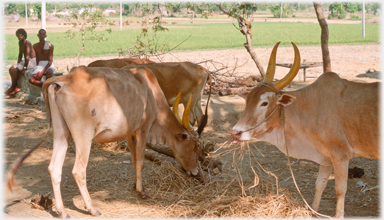 ...Tamil Nadu, have good disease resistance and drought tolerance, but are not fashionable. This particular variety, Kulai Vaalan, with their soft brown colour, are no longer common
...Tamil Nadu, have good disease resistance and drought tolerance, but are not fashionable. This particular variety, Kulai Vaalan, with their soft brown colour, are no longer common
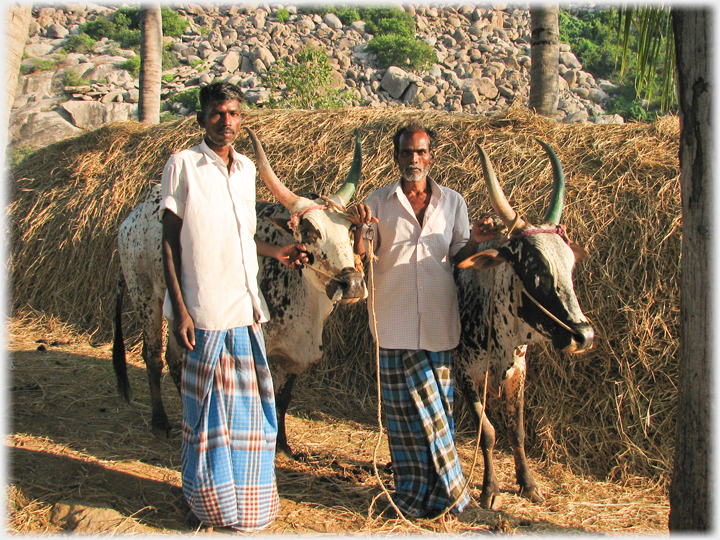 Cattle with decorated horns for Mattu Pongal, (Mattu means bull), the third day of the four day
Pongal Festival
Cattle with decorated horns for Mattu Pongal, (Mattu means bull), the third day of the four day
Pongal Festival
 on which the importance of cattle to the raising of crops is celebrated. The whole Pongal Festival marks the first month after the winter solstice
on which the importance of cattle to the raising of crops is celebrated. The whole Pongal Festival marks the first month after the winter solstice
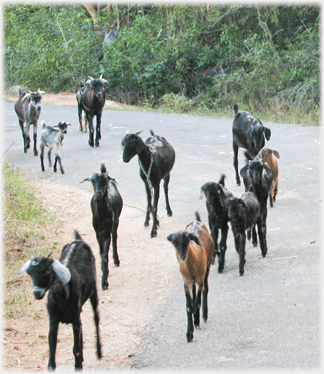 As everywhere in India
goats abound,
As everywhere in India
goats abound,
 this variety are Semeri Aadu. Near the sheep-goat boundary line, they are termed sheep locally
this variety are Semeri Aadu. Near the sheep-goat boundary line, they are termed sheep locally
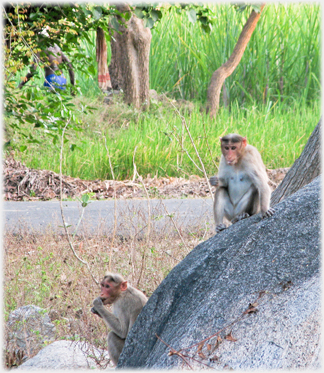 These are Bonnet Macaque monkeys seen around the village and common in southern India - often causing consdierable problems
These are Bonnet Macaque monkeys seen around the village and common in southern India - often causing consdierable problems
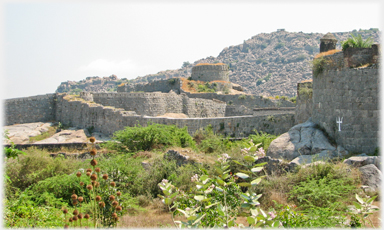 The walls of
Gingee Fort
The walls of
Gingee Fort
 (pronounced roughly 'sinjee' - the main town of the 'Taluk' or local taxation area). It was considered one of the most impregnable defences in India and accordingly called, the 'Troy of the east' by the British
(pronounced roughly 'sinjee' - the main town of the 'Taluk' or local taxation area). It was considered one of the most impregnable defences in India and accordingly called, the 'Troy of the east' by the British
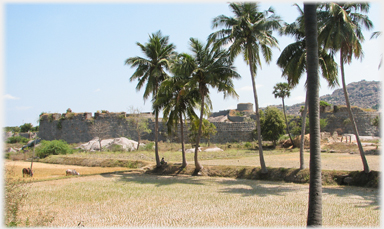 The fortification is 15th century, and is based on earlier 9th century structures> It was built during the period of the
Vijayanagar Empire
The fortification is 15th century, and is based on earlier 9th century structures> It was built during the period of the
Vijayanagar Empire
 which lasted from 1336 to 1646. The walls run for some 13 kilometres and are protected by a 24 metre wide moat
which lasted from 1336 to 1646. The walls run for some 13 kilometres and are protected by a 24 metre wide moat
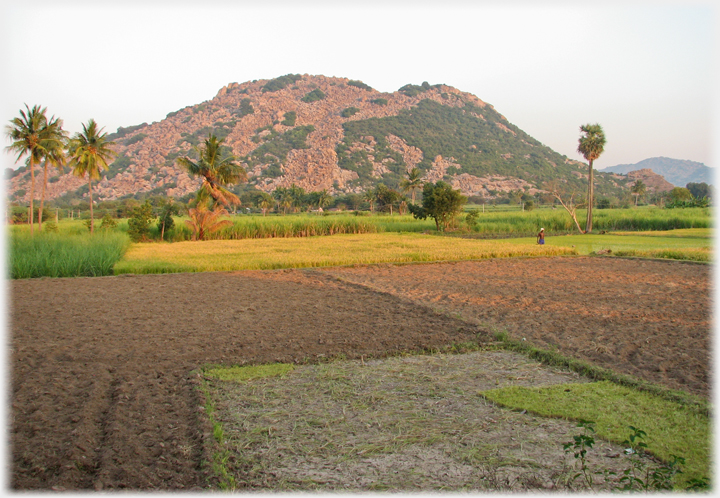 An evening shot of a rocky hill beside Pasumalai Thangal Village which typifies the area; arid rock and paddy fields (watered from very deep bore holes) sweltering from a relentless sun; but the heat eludes the camera
The next page
takes you into the village with shots of the houses and some of the people who live there.
An evening shot of a rocky hill beside Pasumalai Thangal Village which typifies the area; arid rock and paddy fields (watered from very deep bore holes) sweltering from a relentless sun; but the heat eludes the camera
The next page
takes you into the village with shots of the houses and some of the people who live there.
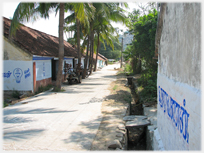

Saturday 11th August 2018

Go to the Picture Posting contents page
Return to the top
|
|
 An ox cart
An ox cart
 at the edge of Pasumalai Thangal Village in the state of Tamil Nadu, (another form of this basic vehicle can be seen at the bottom of the page for
Thành Công Village.
at the edge of Pasumalai Thangal Village in the state of Tamil Nadu, (another form of this basic vehicle can be seen at the bottom of the page for
Thành Công Village.
 )
The horns are decorated for the Pongal Festival - see below
)
The horns are decorated for the Pongal Festival - see below
 Pasumalai Thangal lies a kilometre or so from the main road where the bus passes. My friend and his nephew lead the way towards the village
This page has pictures of the area around the village of Pasumalai Thangal which is some 150 kilometres south-west of Chennai in Tamil Nadu. It is not isolated as Indian villages go, being a few hours bus ride from the state capital, it has mains electricity, and there is some water 30 metres down, but that level is dropping, so a well 600 metres deep is being planned. But apart from those two services life is as far removed as possible from that seen on the
last pages about Singapore.
Pasumalai Thangal lies a kilometre or so from the main road where the bus passes. My friend and his nephew lead the way towards the village
This page has pictures of the area around the village of Pasumalai Thangal which is some 150 kilometres south-west of Chennai in Tamil Nadu. It is not isolated as Indian villages go, being a few hours bus ride from the state capital, it has mains electricity, and there is some water 30 metres down, but that level is dropping, so a well 600 metres deep is being planned. But apart from those two services life is as far removed as possible from that seen on the
last pages about Singapore.
 The page after this one shows more of the village itself.
The page after this one shows more of the village itself.
 Goats grazing in the fields near the village
Goats grazing in the fields near the village
 A man, at the left under the trees, watches as palmyra fruit are collected above him. The curved figure can just be seen, but the gathering technique is better illustrated in the pictures below
A man, at the left under the trees, watches as palmyra fruit are collected above him. The curved figure can just be seen, but the gathering technique is better illustrated in the pictures below
 This area of Tamil Nadu is populated by these stony hills standing up in dry contrast to the green of surrounding paddy fields and trees
This area of Tamil Nadu is populated by these stony hills standing up in dry contrast to the green of surrounding paddy fields and trees

 A billhook is being used to cut off the fruit
A billhook is being used to cut off the fruit
 The tree is ascended and descended without aids
The tree is ascended and descended without aids
 The catch - cut fruits
These trees are Borassus flabellifer, the
palmyra palm,
The catch - cut fruits
These trees are Borassus flabellifer, the
palmyra palm,
 which grows everywhere in, and is the official tree of, Tamil Nadu. It reaches some 30 metres (100 feet) in height, and has many uses including: drinking its sap, eating its sprouts, writing on its leaves, making poles from its trunk, covering roofs with its leaves, and making rope from the fibre of its bark and the stems of its leaves. In these pictures it is of interest for the fruit which we are about to eat. Ayanar, my friend's nephew, is climbing the tree and cutting the fruit from the crown area. Once down he uses the same billhook to open the fruit as he used to dislodge them. It is striking how similar the use of these billhooks is, both here and
in northern Vietnam
which grows everywhere in, and is the official tree of, Tamil Nadu. It reaches some 30 metres (100 feet) in height, and has many uses including: drinking its sap, eating its sprouts, writing on its leaves, making poles from its trunk, covering roofs with its leaves, and making rope from the fibre of its bark and the stems of its leaves. In these pictures it is of interest for the fruit which we are about to eat. Ayanar, my friend's nephew, is climbing the tree and cutting the fruit from the crown area. Once down he uses the same billhook to open the fruit as he used to dislodge them. It is striking how similar the use of these billhooks is, both here and
in northern Vietnam
 3,000 kilometres away.
3,000 kilometres away.
 The end of the nut is sliced off...
The end of the nut is sliced off...
 ...revealing the soft fruit...
...revealing the soft fruit...
 ...a delight for the ever-waiting goats
...a delight for the ever-waiting goats
 Kumaran opens a fruit, while the dogs salivate in anticipation
Kumaran opens a fruit, while the dogs salivate in anticipation
 Jackfruit trees
Jackfruit trees
 are related to figs and mulberries and are native to southern India. One tree has some 100-200 of these 'multiple' fruits, each with 100 to 500 seeds. The seeds are eaten raw or used in cooking, they have a flavour reminiscent of banana
are related to figs and mulberries and are native to southern India. One tree has some 100-200 of these 'multiple' fruits, each with 100 to 500 seeds. The seeds are eaten raw or used in cooking, they have a flavour reminiscent of banana
 Jackfruits (Artocarpus heterophyllus) are Tamil Nadu's official state fruit. The specimens seen here are mere babies for they can grow to weigh up to 55 kilos each
Jackfruits (Artocarpus heterophyllus) are Tamil Nadu's official state fruit. The specimens seen here are mere babies for they can grow to weigh up to 55 kilos each
 Following the State's official tree and its official fruit, these are its unofficial cattle.
Nattu Madu Cattle
Following the State's official tree and its official fruit, these are its unofficial cattle.
Nattu Madu Cattle
 (literally country cattle) are indigenous to ...
(literally country cattle) are indigenous to ...
 ...Tamil Nadu, have good disease resistance and drought tolerance, but are not fashionable. This particular variety, Kulai Vaalan, with their soft brown colour, are no longer common
...Tamil Nadu, have good disease resistance and drought tolerance, but are not fashionable. This particular variety, Kulai Vaalan, with their soft brown colour, are no longer common
 Cattle with decorated horns for Mattu Pongal, (Mattu means bull), the third day of the four day
Pongal Festival
Cattle with decorated horns for Mattu Pongal, (Mattu means bull), the third day of the four day
Pongal Festival
 on which the importance of cattle to the raising of crops is celebrated. The whole Pongal Festival marks the first month after the winter solstice
on which the importance of cattle to the raising of crops is celebrated. The whole Pongal Festival marks the first month after the winter solstice
 As everywhere in India
goats abound,
As everywhere in India
goats abound,
 this variety are Semeri Aadu. Near the sheep-goat boundary line, they are termed sheep locally
this variety are Semeri Aadu. Near the sheep-goat boundary line, they are termed sheep locally
 These are Bonnet Macaque monkeys seen around the village and common in southern India - often causing consdierable problems
These are Bonnet Macaque monkeys seen around the village and common in southern India - often causing consdierable problems
 The walls of
Gingee Fort
The walls of
Gingee Fort
 (pronounced roughly 'sinjee' - the main town of the 'Taluk' or local taxation area). It was considered one of the most impregnable defences in India and accordingly called, the 'Troy of the east' by the British
(pronounced roughly 'sinjee' - the main town of the 'Taluk' or local taxation area). It was considered one of the most impregnable defences in India and accordingly called, the 'Troy of the east' by the British
 The fortification is 15th century, and is based on earlier 9th century structures> It was built during the period of the
Vijayanagar Empire
The fortification is 15th century, and is based on earlier 9th century structures> It was built during the period of the
Vijayanagar Empire
 which lasted from 1336 to 1646. The walls run for some 13 kilometres and are protected by a 24 metre wide moat
which lasted from 1336 to 1646. The walls run for some 13 kilometres and are protected by a 24 metre wide moat
 An evening shot of a rocky hill beside Pasumalai Thangal Village which typifies the area; arid rock and paddy fields (watered from very deep bore holes) sweltering from a relentless sun; but the heat eludes the camera
The next page
takes you into the village with shots of the houses and some of the people who live there.
An evening shot of a rocky hill beside Pasumalai Thangal Village which typifies the area; arid rock and paddy fields (watered from very deep bore holes) sweltering from a relentless sun; but the heat eludes the camera
The next page
takes you into the village with shots of the houses and some of the people who live there.


 The last page had images showing Singapore's sense of style in architecture
The last page had images showing Singapore's sense of style in architecture
 To a page of water and snow - St Mary's Loch in winter
To a page of water and snow - St Mary's Loch in winter
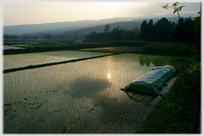 To the area around a village in northern Vietnam - no shortage of water
To the area around a village in northern Vietnam - no shortage of water
